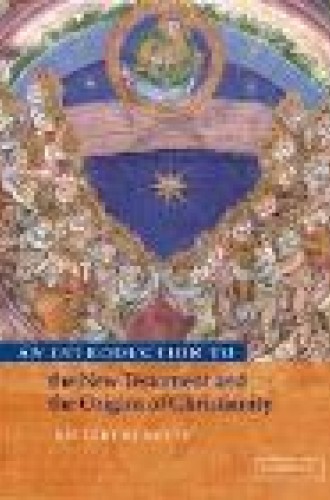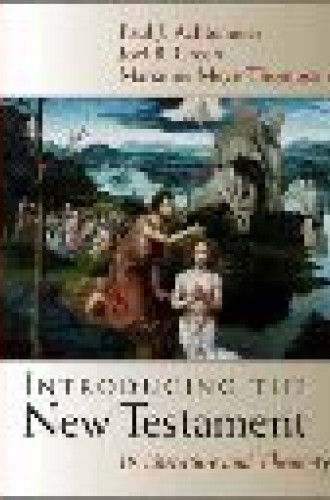Textual appeal
It’s the toughest job you’ll ever love. And no, it’s not the Marine Corps. Teaching an introductory course in New Testament can be worthy of combat pay. This is especially true when most of the students are Christian.
Biblical scholars and their students have very different presuppositions regarding the Bible. If I could explain these presuppositions to my students, I thought, then we could begin to communicate. This strategy eased tensions tremendously. My students began to understand my reasons for making certain moves in interpretation and textbook selection. Nevertheless, teaching Christianity’s sacred texts to Christians can be dangerous—a danger I try to deal with by structuring my New Testament course in a certain way.
Two new introductory textbooks for New Testament studies help clarify why I organize my course as I do. Delbert Burkett uses the historical-critical method as a means of reconstructing early Christian life and faith. Paul J. Achtemeier, Joel B. Green and Marianne Meye Thompson emphasize the New Testament canon as the foundational document of the church. Thompson’s syllabus includes a statement on the course’s relevance for ministry.
I have a particular preference—actually a bias—regarding how a course in New Testament should be taught, and I begin my course by making that preference clear. Like Burkett, I practice the historical-critical method. This means that I read scripture with an eye toward how the text fits into its larger historical context. There are, of course, other ways scriptural texts can be read: for their literary and aesthetic value, for example, or as a model for determining how one should conduct one’s life, which is the way most of my students read scripture. They are concerned with what the text means, whereas I am concerned with what the text meant. Acknowledging this difference is important because it informs the instructor’s theological perspective and has implications for her pedagogical style.
Achtemeier, Green and Thompson structure their book around their joint preference for studying the New Testament primarily as “the decisive witness to Jesus Christ and hence as normative for shaping Christian belief and practice.” They approach the New Testament as a body of literature with a theological content that has meaning for the modern reader. By contrast, Burkett structures his work around his preference for historical investigation. This explains why his book begins with a chapter that emphasizes “the differences between the historical-critical method and the confessional method of studying the New Testament.”
Though Burkett attempts to bring modern relevance to his investigation by adding discussion questions at the end of each chapter, these questions are few and far between. Bridging the chasm between past and present is difficult, and his book only underscores that difficulty. I prefer Burkett’s method over Achtemeier, Green and Thompson’s, but that doesn’t mean I wouldn’t use the latter work at all. If I used it, however, I would probably define my perspective over against that of the authors.
After explaining my perspective, I have to clarify what I want my New Testament course to accomplish. This breaks down into at least two additional questions. First, do I want the course to be an introduction to the discipline of biblical scholarship, or do I want it to be an introduction to the New Testament texts? An introduction to the discipline involves familiarizing students with the history of interpretation and its present practitioners. An introduction to the texts involves orienting students to the various types of literature that make up the New Testament, and the claims or arguments of each. The lectures in my introductory courses are aimed at acquainting students with the texts themselves, while the textbooks I choose introduce them to the discipline.
Second, do I want this course to be an exercise in intellectual or in theological formation? Emphasizing intellectual formation means making connections between this body of literature and the wider project of humanistic inquiry. Theological formation means looking at the New Testament as a document of the church meant for the edification of practitioners of the faith. Since I teach students working for their master of divinity degrees, I want the course to be an exercise in theological formation and thinking. I want my students to see the New Testament as a basic document that informs preaching, teaching, counseling and administration. They should view it as a resource for constructing modern theological claims.
Burkett’s book is more of an introduction to the discipline. It discusses such issues as the two-document hypothesis, the quest for the historical Jesus, proto-orthodoxy in the New Testament and the authorship of the disputed Pauline letters. In addition, it includes discussions of various noncanonical Christian materials, including the apocryphal gospels (e.g., the Infancy Gospel of Thomas). This gives the reader a broader perspective on Christianity as a historical movement involving various manifestations of the faith. It complicates our understanding of Christianity’s development because it follows the historian’s method of not privileging an orthodox theological perspective. Thus, it is an exercise in intellectual formation. Because Burkett, associate professor of religious studies (New Testament and early Christianity) at Louisiana State University, teaches in a liberal arts setting, he is obligated to make connections between these Christian documents and other forms of humanistic inquiry.
Achtemeier, Green and Thompson—from Union Theological Seminary and Presbyterian School of Christian Education in Virginia, Asbury Theological Seminary and Fuller Theological Seminary, respectively—teach at freestanding seminaries devoted to ministerial formation and theological thinking. Their introduction reflects this environment. Though it discusses some of the same disciplinary issues found in Burkett’s book, it is an exercise in theological thinking, Their book intentionally gives privileged place to textual engagement over disciplinary analysis. Both books are balanced in their presentations of scholarly material, but their fundamental orientations ultimately determine how that material is to be read in relation to the New Testament documents themselves. In this instance, I would be more likely to choose Achtemeier, Green and Thompson over Burkett because I teach in an environment that has more in common with theirs than with Burkett’s.
The third thing I do when teaching a course in New Testament is to “guesstimate” my students’ interest in the topic. Some students have a purely confessional interest. That is, they want to see how the New Testament can assist them in their personal faith journeys. Others have a more professional interest. They want to be equipped to negotiate and apply the basic documents that constitute the core of Christian faith and proclamation. Still others have more intellectual interests. They are intrigued by why the New Testament says what it does on questions important to human existence generally. And, finally, some students are resistant to any academic approach to biblical interpretation whatsoever. These students are interested in theological education only because their denominations require it for ordination. This is the toughest group of students to teach. They don’t want to be in your classroom, and they let you know it. Enticing them into an interest in New Testament studies can be difficult. Yet this is my target group. If I can interest them, then the rest of the class will find their interests met in the process.
Achtemeier, Green and Thompson attempt to address students who have a keen interest in the New Testament because they are committed to Christian thinking and practice. Burkett has a much tougher job. He has to convince students in a liberal arts environment that the New Testament is meaningful to their overall educational experience. He makes the study of the New Testament an entirely intellectual matter. This is reflected in statements such as, “In an academic setting . . . we treat Christianity, Islam, Hinduism, and all other religions in the same way: we seek to understand them, not necessarily to adopt or practice them.” I prefer this aspect of Burkett’s approach to Achtemeier, Green and Thompson’s because my goal is to interest those students who do not see the relevance of studying the New Testament for their lives and ministries. Take, for example, the student interested in social-justice issues. She may see the New Testament as oppressive, reflecting the biases and interests of certain ancient elites (i.e., literate individuals who own commodious dwellings and support patriarchal social institutions). If this student can be convinced that the foundational Christian documents can be interpreted in ways that address modern social concerns, then these documents can take their rightful place as an indispensable source of Christian identity and practice. Burkett’s bibliographies provide a basis for this approach in ways that Achtemeier, Green and Thompson’s do not.
Finally, I try in my course to create an environment in which a “fusion of horizons” can take place. In my vision of the ideal teaching environment my scholarly preferences, my goals for the course and my students’ interests would come together. This fusion does not necessarily solve all classroom problems. And some classroom tension is good. It keeps us on our toes. It also allows us to move among a variety of perspectives. I tell students that conversion to my perspective is not the goal of my courses, nor do I want them to uncritically adopt the perspective of the textbook. I want them to see both me and the textbook as critical conversation partners for their own perspectives. You could say that my vision for an introductory course is discordia concors, the harmony or unity gained by combining disparate and conflicting elements.
I must admit that this fusion of horizons does not always occur. So my final pieces of advice regarding the creation of an introductory course in New Testament would be first, ora et labora (pray and work), and second, provide a resource for students that can be reengaged later in their lives. To pray may sound like an odd piece of advice from a historical critic, but just because the efficacy of prayer cannot be critically analyzed does not mean that I exclude its revelatory capacity from my life. Prayer in conjunction with action forms a dynamic framework for teaching.
The right textbook can be an invaluable resource for students later in life. I may not be able to create the best environment for critical inquiry for every student. However, I hope that by selecting the right textbook I give my students an opportunity to engage the New Testament on their own. For many, this will be the only introductory work on the New Testament they will ever own and read. It is important that the text include resources for further study. Again, here I would choose Burkett over Achtemeier, Green and Thompson because he provides a more diverse set of readings for further consideration. But I cannot say conclusively that I will adopt Burkett for my course, nor would I reject the other textbook entirely. Both provide certain perspectives on the conduct of New Testament scholarship that are crucial for the successful creation and execution of an introductory course.







